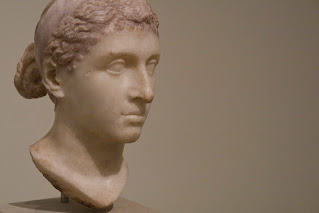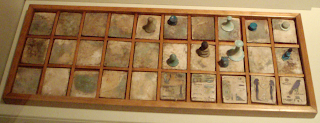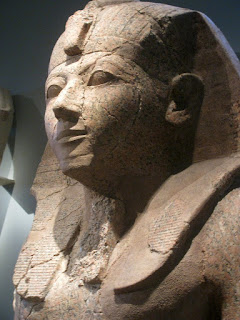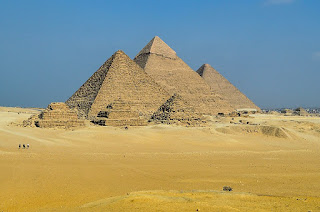Facts You don't Know 11 About Ancient Egypt
According to the British website History, here are 11
facts about ancient Egypt that most people get wrong:
1- Cleopatra was not Egyptian
 |
| Cleopatra |
Besides King Tutankhamun, perhaps no figure is more associated with ancient Egypt than Cleopatra VII.
However, although she was born in Alexandria, she is not of Egyptian origin.
In fact, Cleopatra belonged to a long line of Greek Macedonians descended from Ptolemy I, one of Alexander the Great's most trusted lieutenants.
The Ptolemies ruled Egypt from 323 BC to 30 BC, and most of their leaders remained Greek in their culture and feelings.
Cleopatra was famous for being one of the first members of the Ptolemaic dynasty to speak the Egyptian language.
2- The ancient Egyptians drafted one of the oldest recorded peace treaties
 |
| Oldest peace treaty |
For more than two centuries, the Egyptians fought the Hittite Empire for control of the lands now under modern Syria.
This conflict led to several bloody clashes, such as the Battle of Kadesh 1274 BC; But by the time of Pharaoh Ramses II, neither side had achieved a clear victory.
With the Egyptians and Hittites facing threats from other peoples, both Ramses II and the Hittite king Hattusili III negotiated a famous peace treaty.
Under this agreement, the conflict ended and the parties committed themselves to helping each other in the event of a third party invasion.
This Egyptian-Hittite treaty is now known as one of the first peace agreements to survive in history.
A copy can be seen above the entrance to the United Nations Security Council Chamber in New York City.
3- ancient Egyptians loved chess
After a long day working along the Nile, the ancient Egyptians used to relax and play board games.
They played a lot of different games, including: "Mehen" and "Dog and Jackal".
But the most famous game may be the game of chance known as "Senet".
These games date back to an ancient era in the year 3500 BC, and were played on a long board drawn with 30 squares, and each player gets a set of pieces that move on the board according to the rotation of the dice or the throwing stick.
There is still disagreement among historians over Sennett's detailed rules; But there is little doubt about how widespread the game will be.
The drawings depict Queen Nefertari playing Senet, and her tablets were buried in the tombs of pharaohs such as Tutankhamun.
4-Egyptian women enjoyed a wide range of rights and freedoms
Egyptian women enjoyed a great deal of legal and financial independence.
She could buy and sell property, serve on juries, make wills, and even enter into legal contracts.
Usually, Egyptian women did not work outside the home; But those who worked received equal pay to men working in the same jobs.
Unlike the Greeks, who were effectively owned by their husbands, the Egyptians were given the right to divorce and remarry.
It was common for Egyptian couples to negotiate an old-fashioned prenuptial agreement.
These agreements stipulate all the property and wealth that the woman brought into the marriage, and confirm that she will receive compensation for it in the event of a divorce.
5- Egyptian workers have been known to organize labor strikes
Although they viewed the pharaoh as an image of a living deity, Egyptian workers were not afraid to protest for better working conditions.
The most famous examples of this appear in the twelfth century BC, during the reign of the pharaoh of the New Kingdom, Ramses III, the workers of the royal cemetery at Deir el-Medina organized the first recorded strike in history when they did not receive their usual payments of grain.
The protest took the form of a sit-in, with workers simply entering the nearby funeral temples and refusing to leave until their complaints were heard.
This gamble paid off, and the workers were finally given their backlog.
6- Some Egyptian pharaohs were mostly overweight
Egyptian art generally depicts the pharaohs as elegant and sculpted like statues; But Some time this was not the case.
The Egyptians' diet consisted of beer, wine, bread, and honey, all of which were rich in sugar.
Studies indicate that it may have affected the waists of many kings.
Examinations conducted on the mummies also indicate that many of the rulers of Egypt were unhealthy and overweight, and even suffered from diabetes.
A notable example of this is the legendary Queen Hatshepsut, who lived in the fifteenth century BC.
While her coffin depicts her as slim and athletic, historians believe she was in fact overweight and on the path to baldness.
7- The pyramids were not built by slaves
The life of the builders of the pyramids was certainly not easy, as workers' skeletons were frequently found with signs of arthritis and other diseases.
But the evidence indicates that the huge tombs were not built by slaves, but by paid laborers.
The ancient construction workers were a mixture of skilled craftsmen and temporary labour.
Some of them are very proud of the craft they are good at.
Graffiti on the walls near the ruins indicates that they gave their crews comic names, such as "The drunkard of Menkaure" and "Friends of Khufu".
The idea that the pyramids were built using slaves under a whip was first invented by the Greek historian Herodotus in the fifth century BC.
But historians now reject it and consider it just a myth.
8- The hippopotamus may have caused the death of King Tutankhamun
It is surprising how little we know about the life of the young pharaoh Tutankhamun.
However, some historians believe that they know the manner of his death, as examinations conducted on the body of the young king show that he was embalmed without a heart or a chest.
This severe deviation from Egyptian burial traditions indicates that he may have suffered a terrible injury before his death.
According to a number of Egyptologists, one of the most likely causes of his death was a hippo bite.
Evidence indicates that the Egyptians hunted these beasts for sport, in addition to the statues in King Tut's tomb depicting him during the spear throwing.
If the young pharaoh was indeed fond of chasing dangerous animals, his natural death may have been the result of a hunt that did not go right.
9- Some Egyptian doctors studied specialized fields of study
In the past, the doctor used to practice all specialties.
But the evidence shows that Egyptian doctors sometimes focused on treating only one part of the human body.
This early form of medical specialization was recorded in 450 BC by the historian and traveler Herodotus.
Discussing Egyptian medicine, Herodotus wrote: "Every physician is a healer of one disease and no more...some for the eyes, some for the teeth, and some for the stomach."
These specialists had specific names, dentists were known as "dentists", while colonists were known as "anal shepherds", literally translated.
10- The Egyptians kept many animals as pets
The Egyptians saw animals as the embodiment of the gods, and they were among the first civilizations to keep domestic pets.
The Egyptians were particularly fond of cats, which were associated with the goddess Bastet; But they also preyed on hawks, ibis, dogs, lions, and baboons.
Many of these animals occupied a special place in the Egyptian house, and were often mummified and buried with their owners after their death.
Besides, the Egyptians specially trained other creatures to help animals.
It was known, for example, that the Egyptian police used trained dogs and monkeys to help them on patrols.
11- Egyptians of both sexes used cosmetics
It is known that both men and women wore large amounts of cosmetics, which they believed gave them the protection of the gods Horus and Ra.
These preparations were made by grinding ores such as malachite and galena with kohl.
Thereafter, kohl was extensively illustrated around the eyes with tools of wood, bone, or ivory.
Women dyed their cheeks with red paint, and used henna to color their hands and nails.
Both sexes wore perfumes made of oil, myrrh, and cinnamon.
The Egyptians believed that their cosmetics had magical healing power.
And they weren't entirely wrong on this: Research shows that lead-based cosmetics, used along the Nile, actually helped prevent eye infections.





